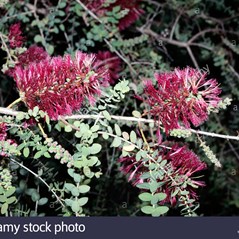Uses: A highly ornamental but hardy foliage plant. Plant singly for contrast as a background plant in wider verges, nature strips and streetscapes or grouped as an informal hedge or barrier. Suitable for parks, reserves, wider roadside plantings. Responds to heavy pruning. Attracts nectar eating birds and insects.
Cultural use: Indigenous peoples used nearly every part of this genus in their day-to-day lives. Fibre and bark for clothing and swaddling babies, drinks made from the nectar, wood and stems for implements and to construct shelters.
Note: This species is classified schedule 1, Regulation 24.2 under the Sewerage Act and may be planted in any street or road in any drainage area provided they are not planted closer than two metres to any sewer main or connection.
- Height 2-4m
- Spread 2-5m
- Position
- Full Sun
- Part Shade
- Family Myrtaceae
- Botanical Name Melaleuca elliptica
- Common Name Granite Honey Myrtle
- Origin WA
- Habit Erect, Spreading to ascending
- Landscape 2nd line coast, Coast, Coastal cliffs, Coastal footslopes, Hills, Plains
- Soil Texture Clay, Loam, Rock, Sand
- pH Acidic, Alkaline, Neutral
- Tolerates Drought, Lime, Moderate frost, Salt spray
- Supplementary Watering Minimal
- Flower Colour Red
- Flowering Time Autumn, Spring
- Flower Type Bottlebrush
- Purpose Wind protection, Ornamental, Habitat
- Form Medium Shrub (Usually between 1.2m & 3.6m)







